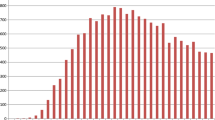Summary
Microdialysis is a method by which the extracellular fluid from almost any organ or fluid compartment can be sampled without loss of volume for long periods of time. By this method direct access is gained to previously intractable fluid spaces such as the brain extracellular fluid and the mechanisms of transfer over, for example, the blood brain barrier (BBB) and the blood placenta barrier can be studied with fewer assumptions made than previously. We here concentrate on three aspects of the use of microdialysis in pharmacokinetics. Firstly, some of the practical experimental requirements are reviewed with particular attention paid to the recovery problem. Secondly, the calculation of pharmacokinetic parameter estimates is discussed including an algorithm for dealing with multicompartment models and direct studies of transfer rate constants. Thirdly, the possibility to model and experimentally examine various transport mechanisms is discussed. The theoretical results are applied to data from a study of the anti-HIV drugs zidovudine and alovudine (3′-fluorothymidine) and their distribution across the blood brain barrier in rats.
Similar content being viewed by others
References
Guyton A.C. (1963): A concept of negative interstitial pressure based on pressures in implanted perforated capsules. Circ. Res., 12, 399–414.
Chisholm G.D., Waterworth P.M., Calnan J.S., Garrod L.P. (1973): Concentration of antibacterial agents in interstitial tissue fluid. BMJ, 1, 569–573.
Ungerstedt U., Pycock C. (1974): Functional correlates of dopamine neurotransmission. Bull. Schweitz Akad. Med. Wiss., 1278: 1–5.
Bito L., Davson H., Levin E., Murray M., Snider N. (1966): The concentrations of free amino acids and other electrolytes in cerebrospinal fluid, in vivo dialysates of brain and blood plasma of the dog. J. Neurochem., 13, 1057–1067.
Delgado J.M., DeFeudis F.V., Roth R.H., Ryugo D.K., Mitruka B.M. (1972): Dialytrode for long term intracerebral perfusion in awake monkeys. Arch. Int. Pharmacodyn. Ther., 198, 9–12.
Brodie M.S., Lee K., Fredholm B.B., Ståhle L., Dunwiddie T.V. (1987): Central versus peripheral mediation of responses to adenosine receptor agonists: evidence against a central mode of action. Brain Res., 415, 323–330.
Hurd Y.L., Kehr J., Ungerstedt U. (1988): In vivo microdialysis as a technique to monitor drug transport: correlation of extracellular cocaine levels and dopamine overflow in rat brain. J. Neurochem., 51, 1314–1316.
Sabol K.E., Freed C.R. (1988): Brain acetaminophen measurement by in vivo dialysis, in vivo electrochemistry and tissue assay: a study of the dialysis technique in the rat. J. Neurosci. Meth., 24, 163–168.
Dubey R.K., McAllister C.B., Inoue M., Wilkinson G.R. (1989): Plasma protein binding and transport of diazepam across the blood-brain barrier. No evidence for in vivo enhanced dissociation. J. Clin. Invest., 84, 1155–1159.
Amberg G., Lindefors N. (1989): Intracerebral microdialysis. I. Mathematical studies of diffusion kinetics. J. Pharmacol. Meth., 23, 157–183.
Benveniste H., Hansen A.J., Ottosen N.S. (1989): Determination of interstitial concentrations by microdialysis. J. Neurochem., 52, 1741–1750.
Bungay P.M., Morrison P.F., Dedrick R.L. (1990): Steady-state theory for quantitative microdialysis: application to in vivo sampling of tritiated water. Life Sc., 46, 109–119.
Morrison P.F., Bungay P.M., Hsiao J.K., Ball B.A., Mefford I.N., Dedrick R.L. (1991): Quantitative microdialysis: analysis of transients and application to pharmacokinetics in brain. J. Neurochem., 57, 103–119.
Ståhle L. (1991): Drug distribution studies with microdialysis. I: Tissue dependent difference in recovery between caffeine and theophylline. Life Sci., 49, 1835–1842.
Jacobsson I., Sandberg M., Hamberger A. (1985): Mass transfer in brain dialysis devices — a new method for the estimation of extracellular amino acid concentration. J. Neurosci. Meth., 15, 263–268.
Lönnroth P., Jansson P-A., Smith U. (1987): A microdialysis method allowing characterization of extracellular water space in humans. Am. J. Physiol., 253, E228-E231.
Ståhle L., Segersvärd S., Ungerstedt U. (1991): A comparison between three methods for estimation of extracellular concentrations of exogenous and endogenous compounds by microdialysis. J. Pharmacol. Meth., 25, 41–52.
Ståhle L., Segersvärd S., Ungerstedt U. (1991): Drug distribution studied by microdialysis. II: Distribution of caffeine and theophylline to brain and other tissues in the rat. Life Sci., 49, 1843–1852.
Ekblom M., Gårdmark M., Hammarlund Udenäs M. (1992): Estimation of unbound concentrations of morphine from microdialysate concentrations by use of non-linear regression analysis in vivo and in vitro during steady state conditions. Life Sci., 51, 449–460.
Ståhle L., Segersvärd S., Ungerstedt U. (1990): Estimation of theophylline in brain extracellular space by microdialysis: relation to behaviour. Eur. J. Pharmacol., 185, 187–193.
Ståhle L., Amer P., Ungerstedt U. (1991) Drug distribution studied by microdialysis. III: Levels of caffeine in human subcutaneous adipose tissue. Life Sci., 49, 1853–1858.
Ljungdahl-Ståhle E., Guzenda E., Böttiger D., Wahren B., Öberg B., Ståhle L. (1992): A study of the penetration of 3′-fluorothymidine and zidovudine to brain and muscle in cynomolgus monkeys studied by microdialysis: relation to effects against simian immunodeficiency virus. Antimicrob. Agents Chemother., 36, 2418–2422.
Ståhle L., Guzenda E., Ljungdahl-Ståhle E. (1993): Penetration of 3′-fluorothymidine and zidovudine to muscle and brain in the rat studied by microdialysis. J. Acquired Immun. Def. Syndr., In press.
Ståhle L. (1992): Pharmacokinetic estimations from microdialysis data. Eur. J. Clin. Pharmacol., 43, 289–294.
Rudin W. (1976): Principles of Mathematical Analysis. Singapore, McGraw Hill.
Gibaldi M., Perrier D. (1982): Pharmacokinetics. New York, Dekker.
Simmons GK. (1972): Differential Equations. New Delhi, Tata McGraw Hill.
Rowland M., Tozer T.N. (1989) Clinical pharmacokinetics. Concepts and applications. 2nd edn. Philadelphia, Lea & Fibiger.
Author information
Authors and Affiliations
Additional information
Dedicated to Ewa Ljungdahl Ståhle on her 40th birthday, December 26, 1992.
Rights and permissions
About this article
Cite this article
Ståhle, L. Microdialysis in pharmacokinetics. Eur. J. Drug Metab. Pharmacokinet. 18, 89–96 (1993). https://doi.org/10.1007/BF03220011
Issue Date:
DOI: https://doi.org/10.1007/BF03220011



